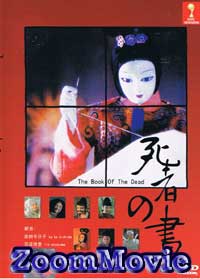The Book of The Dead aka Shisha no Sho
Japanese Movie DVD English Sub
SKU :

Out of Stock
- Disc
-
DVD ×1 pcs
- Region Code
- All
- Video
- NTSC Fullscreen
- Audio
- Japanese
- Subtitle
- English / Chinese / Malay
Out of Stock
- Title
- The Book of The Dead aka Shisha no Sho
- Japanese Title
- 死者の書
- Listing Date
- 2008-12-06
Director:
Kihachiro Kawamoto
Kihachiro Kawamoto
Starring:
Kyoko Kishida, Rie Miyazawa
Kyoko Kishida, Rie Miyazawa
Synopsis:
The Book of the Dead (Shisha no Sho) is a 2005 stop motion-animated feature film directed by Kihachiro Kawamoto. The film is based on a novel by Shinobu Orikuchi and in the Nara period at around 750 CE, the era when Buddhism was being introduced from China.
Iratsume, a young woman from a noble house, becomes obsessed with the new religion and spends much of her time hand-copying the sutras, trying to understand the teachings of the buddha. On the eve of each equinox and solstice she begins to see a radiant figure looking not unlike the buddha floating between the twin peaks of distant Mount Futakami.
One evening, after completing her one-thousandth copy of a sutra, her view the figure she has been longing to see again is obscured by a rainstorm. In pursuit of it she slips away from her household to the foot of the mountain, where she arrives at a temple that women are forbidden to enter. There she learns that the figure might not be buddha, but the soul of the executed Prince Otsu which wanders in torment between this world and the next. When Iratsume and Otsu's soul encounter, they feel compelled to unite. They forge a bond, bringing comfort and peace to each other - a bond that allows the prince's soul to find rest.
The film follows the Japanese teaching that came from Buddhism: that no matter who they are, friends or foes, the souls of the dead need to be relieved. Kawamoto has said that the film is dedicated to all the innocent people who have died in recent wars.
The Book of the Dead (Shisha no Sho) is a 2005 stop motion-animated feature film directed by Kihachiro Kawamoto. The film is based on a novel by Shinobu Orikuchi and in the Nara period at around 750 CE, the era when Buddhism was being introduced from China.
Iratsume, a young woman from a noble house, becomes obsessed with the new religion and spends much of her time hand-copying the sutras, trying to understand the teachings of the buddha. On the eve of each equinox and solstice she begins to see a radiant figure looking not unlike the buddha floating between the twin peaks of distant Mount Futakami.
One evening, after completing her one-thousandth copy of a sutra, her view the figure she has been longing to see again is obscured by a rainstorm. In pursuit of it she slips away from her household to the foot of the mountain, where she arrives at a temple that women are forbidden to enter. There she learns that the figure might not be buddha, but the soul of the executed Prince Otsu which wanders in torment between this world and the next. When Iratsume and Otsu's soul encounter, they feel compelled to unite. They forge a bond, bringing comfort and peace to each other - a bond that allows the prince's soul to find rest.
The film follows the Japanese teaching that came from Buddhism: that no matter who they are, friends or foes, the souls of the dead need to be relieved. Kawamoto has said that the film is dedicated to all the innocent people who have died in recent wars.
Customer Reviews
AsobiAsia

